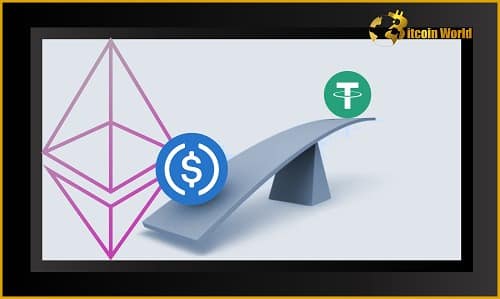Hold onto your hats, crypto enthusiasts! We’ve witnessed a significant shift in the stablecoin arena. For years, Tether’s USDT reigned supreme, but a new contender has stepped into the limelight – Circle’s USD Coin (USDC). In a landmark moment, USDC has officially overtaken USDT in total supply on the Ethereum network. Let’s dive into what this means and why it’s making waves in the crypto world.
USDC Edges Out USDT on Ethereum: What Happened?
As of now, USDC boasts a supply of 40.06 billion tokens on the Ethereum blockchain, narrowly surpassing USDT’s 39.82 billion. While the difference is slight, the symbolism is huge. Think of it as a marathon where the underdog finally inches ahead of the long-standing champion.
USDT has been the king of stablecoins since its inception in late 2014, initially operating on the Omni Layer. Back then, it shared the stage with other stablecoin hopefuls like BitUSD and NuBits (USNBT). However, as these early competitors faltered, losing their dollar peg, USDT solidified its position. Then came USDC in 2018, presenting itself as a more transparent and regulated alternative to Tether, which had been facing scrutiny about its reserves for quite some time.
Despite this Ethereum network shift, USDT still holds the crown for overall supply across all networks, standing strong at 78.5 billion tokens. Interestingly, a significant chunk of USDT’s supply, around 38.7 billion tokens, resides on the Tron network. USDT’s reach is extensive, spanning across 13 other blockchains and layer-2 solutions, including Binance Smart Chain (BSC), Solana, Huobi ECO Chain, Avalanche, and Polygon, showcasing its widespread adoption across the crypto ecosystem.
USDC’s Multi-Chain Presence: A Growing Footprint
USDC isn’t confined to just Ethereum. It’s making its presence felt across a broad spectrum of networks. Currently, USDC has a total supply of 45.7 billion coins distributed across 21 different chains and layer-two solutions. This multi-chain strategy underscores USDC’s ambition to be a versatile and widely accessible stablecoin.
Why is Transparency a Hot Topic in the Stablecoin World?
Tether’s journey hasn’t been without its bumps. Over time, questions surrounding the backing of USDT have cast a shadow over its public image. Concerns about the collateralization of the stablecoin and the management of its reserve funds have been persistent. Even the release of Consolidated Reserves Reports by accounting firm Moore Cayman in 2021 didn’t entirely quell the doubts for some.
Commercial Paper Concerns: What’s the Deal?
In its most recent financial disclosures, Tether revealed holding $30.8 billion in unspecified commercial paper as part of its reserves, alongside other assets backing USDT. The lack of specificity around this commercial paper has fueled further debate and calls for greater transparency in stablecoin reserves.
USDC’s Approach: Openness and Regulation
In contrast, Circle has adopted a more transparent stance regarding its reserves, although some critics argue for even greater detail. Back in August 2021, Coinbase President Emilie Choi announced that USDC reserves would be entirely composed of cash and US Treasury bonds. By October 27, 2021, an Independent Accountant’s Report from Grant Thornton confirmed this to be the case, bolstering confidence in USDC’s backing.
The Coinbase-Circle Connection: A Powerful Partnership
Coinbase plays a pivotal role in the USDC story as a close partner of Circle, the digital payments company that launched USDC in October 2018. Circle also boasts investments from notable entities like Bitmain, China Everbright Bank, and several others, highlighting its strong industry backing.
The Future of Stablecoin Regulation: What’s on the Horizon?
Circle has actively advocated for a clear and unified regulatory framework for stablecoins. CEO Jeremy Allaire publicly supported a proposal from the Biden administration in November 2021 to regulate stablecoin issuers similarly to banks. In December 2021, Allaire joined other crypto leaders at a Congressional hearing to discuss policy directions with the Financial Services Committee. This proactive engagement in regulatory discussions signals a commitment to operating within a well-defined legal framework.
Currently, the top three stablecoins are USDT, USDC, and Binance USD (BUSD). However, the landscape is evolving, with decentralized stablecoin options gaining traction, offering alternatives to centralized models. The competition and innovation in the stablecoin space are only set to intensify as the crypto market matures.
Related Reads: – Ex-SEC Chair, Jay Clayton Believes Cryptocurrency Industry Is For Long Haul
In Conclusion: A Stablecoin Power Shift?
USDC surpassing USDT on Ethereum is more than just a number; it represents a potential shift in the stablecoin hierarchy, at least within the Ethereum ecosystem. While USDT maintains its overall lead, USDC’s growing Ethereum presence and emphasis on transparency resonate with a segment of the crypto community increasingly focused on regulatory compliance and asset backing. The stablecoin race is far from over, and it will be fascinating to watch how these dynamics unfold and shape the future of digital finance.
Disclaimer: The information provided is not trading advice, Bitcoinworld.co.in holds no liability for any investments made based on the information provided on this page. We strongly recommend independent research and/or consultation with a qualified professional before making any investment decisions.


